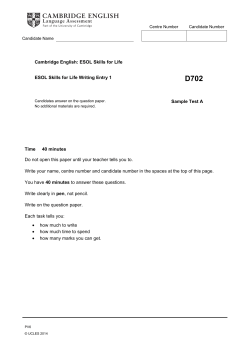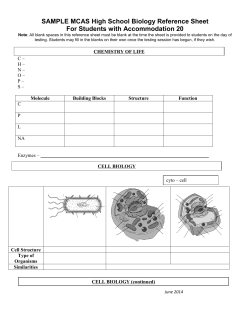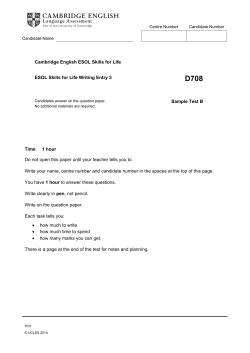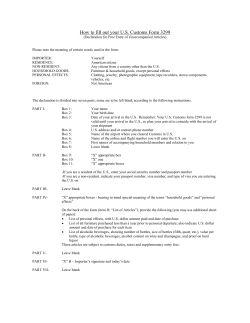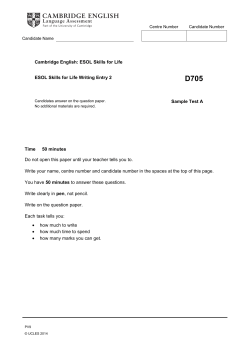
FlaEnt_FormattingGuidelines_GeneralManuscripts_25Mar2015
1
Running head: Smith et al.: The running head is in sentence case (max. 60 characters or spaces)
2
3
4
5
6
7
8
9
10
11
Please address correspondence to:
Carmen Lucia Moreira De Souza
Faculdade de Agronomia
Universidade do Rio de Janeiro
79.804-970, Rio de Janeiro, Brazil
Phone: +55 (71) 5432-7891
E-mail: clm101@gmail.com
Financial contact for invoice: name, complete mailing address, and e-mail address
(if same as corresponding author, write “Same”)
[BLANK LINE]
12
Precise title in sentence case, 16 pt bold font, centered, with name of
13
insect (Order: Family)—use either ESA-accepted common name or
14
Latin binomial, not both, and do not include the authority for
15
taxonomic names
16
[BLANK LINE]
17
John E. Smith1, Mitsuo Nukaya2, and Carmen Lucia Moreira De Souza3*
1
18
University of Florida, Department of Entomology & Nematology, Gainesville, Florida 32611,
19
USA
20
[BLANK LINE]
21
2
The University of Tokyo, Department of Agricultural & Environmental Biology, Yayoi, Tokyo,
22
113-8657, Japan
23
[BLANK LINE]
24
3
Faculdade de Agronomia, Universidade do Rio de Janeiro, 79.804-970, Rio de Janeiro, Brazil
25
[BLANK LINE]
26
*Corresponding author; E-mail: clm101@gmail.com
27
[PAGE BREAK]
1
28
Abstract
29
[BLANK LINE]
30
Left-justify the word Abstract. Capitalize the first letter only. Do not indent the Abstract heading
31
and the first line of the text. Do not cite references, figures, or tables in the abstract. Avoid long
32
lists of methods or detailed explanations. Give the systematic authority at first mention of an
33
organism’s Latin name, order, and family in the abstract and the text. Spell out all authorities
34
except Linnaeus (L.) and Fabricius (F.). The primary purpose of an abstract is to explain to the
35
general reader why and how the research was done and why the results should be viewed as
36
important. It briefly provides the (i) background and purpose, (ii) methods, (iii) results, (iv)
37
conclusion(s), and (v) significance and impact as in the following example. (Note: The following
38
bold-font grey words in brackets shown in this abstract are for guidance only; do not insert
39
these words in your abstract.) [Background and Purpose:] The red palm weevil,
40
Rhynchophorus ferrugineus (Olivier) (Coleoptera: Curculionidae), is an economically significant
41
pest of palm trees. By the time a palm infested with weevils displays visible damage, larvae have
42
destroyed much of the trunk’s internal structure, typically resulting in tree mortality. Acoustic
43
technology may enable pest managers to detect and treat early weevil infestations before tree
44
mortality. This study was conducted to determine the detectability of sounds produced by early
45
instars in open, urban environments and in enclosures with approximately 10 dB acoustical
46
shielding. [Methods:] Recorded signals were analyzed to identify larval sound impulse bursts,
47
trains of 7 to 200 impulses, 3 to 30 ms in duration, where impulses within the train were
48
separated by less than 0.25 s. For a burst to be considered a larval sound, it was specified that
49
most of its impulses must have spectra that match mean spectra (profiles) of known larval sound
50
bursts more closely than profiles of background noise or known non-targeted sound sources.
2
51
[Results:] Larval bursts were detected in > 80% of palm fronds inoculated with neonates the
52
previous day. There were no significant differences between burst rates in enclosed and open
53
environments, but the shielding provided by the enclosure enabled detection of early instars from
54
greater distances. [Conclusions:] Thus, there is potential to use acoustic technology to detect
55
early red palm weevil infestation in either minimally shielded or open environments. In addition,
56
because late-instar impulses ranged to higher amplitude and had greater diversity of spectral
57
features than early-instar impulses, it may be possible to identify late-instar infestations based on
58
the amplitudes and the diversity of sound features detected. [Significance and Impact of the
59
Study:] Larvae of all instars can be detected over distances of at least 5 to 10 cm in shielded and
60
exposed environments. In quiet environments it seems possible to detect early instars at distances
61
up to 0.5 to1 m, whereas late instars can be detected at distances of 1 to 4 m. Step-wise
62
procedures for identifying a weevil infestation in the field are elaborated.”
63
[BLANK LINE]
64
Key Words: type 4 to 6 key words other than words in the title; separate them with
65
semicolons; do not type a period at the end
66
[BLANK LINE]
67
Resumen
68
[BLANK LINE]
69
Left-justify the word Resumen. If you have prepared a Spanish translation, place it here,
70
otherwise leave it blank. Do not attempt a translation unless you (or your translator) are fluent in
71
Spanish. The Spanish Abstract Associate Editor will provide a translation. A Portuguese
72
translation (Resumo and Palavras Chave) is also accepted.
73
[BLANK LINE]
3
74
Palabras Clave: type 4 to 6 palabras clave corresponding to those you listed in the Key Words
75
[PAGE BREAK]
4
76
This document is an example of the Florida Entomologist formatting style. Your
77
submission should resemble the editorial style of this document. All submissions must be in
78
Microsoft Word (.doc or .docx). Use continuous line numbering of lines on all pages of your
79
manuscript. Type all text and captions (including text in tables) with double-spaced lines (except
80
single-spaced contact information on top of the title page). Left-justify all text and indent (0.5
81
inches) all paragraphs. Do not use hyphenation on line endings. Use 12 pt font throughout
82
manuscript (except 16 pt font in 1st-level headings). Do not use bold font except where
83
absolutely necessary, such as to indicate the surname (family name) of each author on the title
84
page and to indicate sp. nov. and. gen. nov. Use italic font only for scientific names (i.e., Latin
85
binomials), certain statistical abbreviations (see below), mathematical equations, and 4th-level
86
headings. The introduction should describe the paper's significance. Note that there is no heading
87
for this section. State the reason for doing the research, the questions or hypotheses, and the
88
essential background. Give the scientific name (i.e., Latin binomial), authority, and taxonomic
89
classification (Order: Family) at first mention of each organism. After the first mention,
90
abbreviate the genus name of the organism, unless it is at the beginning of a sentence (i.e., spell
91
out an organism’s genus name at the beginning of a sentence). Refer to the Catalogue of Life for
92
accepted taxonomic placement (http://www.catalogueoflife.org/annual-
93
checklist/2014/search/all). Use common names according to the listing of the Entomological
94
Society of America (ESA). Do NOT use acronyms or abbreviations (like ECB for European corn
95
borer). Plant cultivars follow the species name and authority, with capital initial letter, regular
96
font (NOT italics), in single quotation marks upon first mention; afterwards (unless confusion is
97
possible), omit quotation marks when the cultivar is mentioned without the species name. Name
5
98
plant viruses in accordance with Fauquet & Mayo (1999) Archives of Virology 144(6): 1249-
99
1273.
100
A sentence must not begin with an abbreviation or a numeral. In other words, spell out
101
genus names, numbers, and abbreviated terms (or add an article before the abbreviated term) at
102
the beginning of a sentence. Citations in the text are included in the name-date format: Jones
103
(1986); (Jones 1986); Jones & Smith (1986); (Jones & Smith 1986); Jones (in press); (Jones AF,
104
Department of Zoology, Ohio State University, personal communication). When 2 or more in-
105
text citations are used, they must be separated with semicolons, for example “(Ball 1970;
106
Menendez 1980; Jones & Smith 1986).” However, several citations by the same author(s) are
107
separated by commas, such as “(Jones & Smith 1986, 1992, 2014)”. List multiple citations in
108
chronological order. Use “et al.” for 3 or more authors, but do not italicize “et al.” Provide
109
evidence of acceptance for works “in press,” otherwise cite as “unpublished” or “personal
110
communication.” Provide written permission from personal communicants.
111
The structure of taxonomic manuscripts is different from the structure of general research
112
papers. Please refer to the Taxonomic Manuscripts Formatting Template (posted online:
113
http://www.flaentsoc.org/auinstr.htm) when preparing a taxonomic manuscript.
114
[BLANK LINE]
115
Materials and Methods [16 pt bold font]
116
[BLANK LINE]
117
Note that there is a blank line above and below the heading. Left-justify and indent (0.5
118
inches) all paragraphs. Report geographical coordinates as, for example, “Gainesville
119
(29º39'05"N, 82º19'29"W), Florida,” and use the symbols for degrees (º), minutes (', i.e., normal
6
120
text Basic Latin apostrophe), and seconds (", i.e., normal text Basic Latin quotation mark); note
121
that there are no spaces except after the comma.
122
Use numerals (NOT words) to express whole and decimal numbers, for example “3
123
objectives, 8 samples, 4 times, 0.5 m.” Exceptions: Spell out a number at the beginning of a
124
sentence or title, a number adjacent to another number (e.g., “four 100 mL samples”), and zero
125
and one when used generally (e.g., “values above zero,” “at one time”). Use numerals to
126
designate mathematical relationships as in “2:1 sex ratio (female: male), at 5 magnification, a 3-
127
fold increase.”
128
Use metric units unless there is specific reason to include English units, then include the
129
English equivalents in parentheses. Do not abbreviate “liter” except in units of measure, such as
130
mL and μL. For numerals with units of measure, use the symbols accepted by the Système
131
International (SI). Separate mathematical operators and units of measure from numerals with one
132
space (e.g., 3.7 ± 1.1 mm; P = 0.05), but do not leave a space between a numeral and % (e.g.,
133
75%). For temperatures, insert a space before (but not after) the “degree” symbol (e.g., 27 ºC).
134
Describe dimensions as “20 25 10 cm” or as “20 cm L 25 cm W 10 cm H.” Do not use a
135
hyphen between numerals and units when they specify a noun as in “a 7.4 mL glass vial” (NOT
136
“a 7.4-mL glass vial”). Use regular (NOT superscript) formatting for ordinals as in “1st, 2nd, and
137
3rd instars.” For more information on the use of numerals, ordinals, and units of measure, refer
138
to the Scientific Style and Format of the Council of Science Editors (previously [until 2000]
139
known as the Council of Biology Editors).
140
Use the following format for photoperiod: 14:10 h L:D. Spell out names of countries,
141
states, and provinces, with the exception of USA. Report months using the 3-letter system (e.g.,
142
Jan, Feb, Mar), but in taxonomic reports use Roman numerals (e.g., 15-VI-2012). In dates, do
7
143
not place a zero before a numeral, use the 3-letter abbreviation (without period), und write the
144
date in the order day-month-year, for example write 2 Apr 2010 (not 02 Apr 2010, not 2 April
145
2010, not April 2, 2010, and not Apr 2, 2010). For other abbreviations, refer to the Scientific
146
Style and Format of the Council of Science Editors.
147
The study design must be clear so the statistical analysis can be understood. The reader
148
should be able to determine where the study plots were located, how sampling was performed in
149
space and time, what data were collected, what parameters were calculated, and how data were
150
analyzed. With complex studies, it may be appropriate to divide the methods into separate units
151
identified by subheadings, and then continue the subheading organization in the Results section.
152
Large-scale datasets, sequences, and computational models should be deposited in one of the
153
relevant public databases (e.g., GenBank of the National Center for Biotechnology Information
154
[NCBI]) before submission, and authors should include accession codes in the Materials and
155
Methods section. Alternatively, material can be included as “supplementary material,” which is
156
submitted as a Microsoft Word document and published online in pdf format, via an “infolink”
157
associated with the online version of the manuscript. Supplementary material may include tables,
158
graphics, color photographs, videos, etc. The corresponding author must alert the editor in chief
159
about the need to upload supplementary material before the manuscript has been sent to the
160
printing company. Please refer to the instructions posted online
161
(http://www.flaentsoc.org/infolink.htm) to prepare supplementary material.
162
Statistical analyses must be described in detail. Cite the method or software used. In
163
regressions, specify the model, define all variables, and provide estimates of variance. Use
164
uppercase “N” for population size and lowercase “n” for sample size. Following is an example of
165
suitable description: “Within each experiment, treatment effects were analyzed by using repeated
8
166
measures ANOVA (P < 0.05) over multiple dates, and differences between treatment means
167
were distinguished with the least-square differences (LSD) test (SAS Version 9.1, SAS Institute,
168
Cary, North Carolina, USA). Percentage data (mortality) were arcsine transformed and numerical
169
data (insect abundance) were square-root transformed prior to analyses. Non-transformed means
170
are presented in the figures.”
171
Under Materials and Methods, use up to 3 additional levels of heading with the
172
following formats:
173
[BLANK LINE]
174
EXPERIMENTAL LOCATIONS [2nd-level heading, all capital letters]
175
[BLANK LINE]
176
Text begins with indent. Leave one blank line above and below heading.
177
[BLANK LINE]
178
Spring Sampling Period for Immatures [3rd-level heading; capitalize first letter of major words;
179
do not capitalize first letter of an article, conjunction, preposition, or pronoun]
180
[BLANK LINE]
181
Text begins with indent. Leave one blank line above and below heading.
182
Sampling Terminal Leaves. This 4th-level heading is indented and italicized; it is
183
followed immediately by the text. Do not insert a blank line above this heading.
184
[BLANK LINE]
185
Results [16 pt bold font]
186
[BLANK LINE]
187
188
Leave a blank line above and below the heading. Indent (0.5 inches) all paragraphs.
Results generally should be stated concisely and without interpretation. However, with complex
9
189
studies, modest interpretation of individual parts can provide context helpful for understanding
190
subsequent parts. Keep the Results section and the Discussion section separate. The editor of
191
the Florida Entomologist will not accept manuscripts with a combined Results and Discussion
192
section.
193
When presenting the results of analysis of variance or t-tests, specify F or t, degrees of
194
freedom (df), and probability level (P) either in the text or table (e.g., F = 19.76; df = 1,28; P <
195
0.001). Note that t, F, and P are italicized, but df is not. An example for reporting regression
196
is “The time required to complete larval development was related to air temperature (t = 3.15; df
197
= 14; P < 0.001). Larval development time (days) decreased with increasing air temperature by
198
the relation: days = 3.2 − (5.6 ± 1.2 [SD]) (ºC).
199
Under Results, use up to 3 additional levels of heading, as described above under
200
Materials and Methods. Number tables and figures with Arabic numerals in the order in which
201
you cite them in the text. In running text, refer to Table 1 or Figure 2. In parentheses, refer to
202
(Table 1; Fig. 2). When you prepare tables, summarize your data (i.e., do not present raw data)
203
so that each table fits on a regular page. See an example on Page 15 of this document. When you
204
prepare figures, keep photos and line drawings (i.e., graphs) separate. Combine individual photos
205
into a photo plate, and combine similar graphs into one figure plate. PRINTING OF COLOR
206
PHOTOS IS MUCH MORE EXPENSIVE THAN PRINTING OF BLACK-AND-WHITE
207
PHOTOS OR LINE DRAWINGS, SO IT IS IN YOUR INTEREST TO GROUP COLOR
208
PHOTOS ON SEPARATE PLATE(S).
209
[BLANK LINE]
210
Discussion [16 pt bold font]
211
[BLANK LINE]
10
212
Leave a blank line above and below the heading. Indent (0.5 inches) all paragraphs. The
213
discussion should explain the significance and impact of the results. The objectives of the
214
discussion include (1) interpreting the results, especially in relation to the literature, (2)
215
connecting the results to the objectives or hypotheses stated in the introduction, and (3) reflecting
216
on the importance of the results. Avoid excessive repetition of the results.
217
Under Discussion, headings may be inserted as needed.
218
[BLANK LINE]
219
Acknowledgments [16 pt bold font]
220
[BLANK LINE]
221
Leave a blank line above and below the heading. Indent (0.5 inches) this paragraph. Do
222
not use titles before names. Generally, people precede grants. Spell out institutions. You may
223
include disclaimers such as “mention of trade names does not imply recommendation or
224
endorsement.”
225
[BLANK LINE]
226
References Cited [16 pt bold font]
227
[BLANK LINE]
228
Leave a blank line above and below the heading. Use a hanging indent (0.5 inches) as shown in
229
the examples below. Begin each reference on a new line (without a blank line). Put initials of
230
each author after the surname (family name) (e.g., Jones BJ, Smith CA. 2008.). Do not use
231
punctuation except for a comma to separate names of different authors. Do not include “and”
232
preceding the last name in a series. Include all references cited in the manuscript. Provide all
233
information that would allow retrieval of the material including the volume and issue numbers of
234
a journal or the name and location of a book publisher. Spell out journal names (e.g., Journal of
11
235
Economic Entomology). The journal name is followed by the volume number, a colon, and the
236
page range; place a hyphen between page numbers and a period at the end; for example “Florida
237
Entomologist 84: 111-115.” Use sentence case for titles of journal articles, book chapters,
238
reports, and theses. Capitalize major words (but not articles, conjunctions, prepositions, and
239
pronouns) in book titles. Follow the grammar and spelling rules of foreign languages if you are
240
citing original articles (e.g., in German titles, adjectives and adverbs do not have an initial capital
241
letter). The order of the references is alphabetical by 1st author. For 2 or more references by the
242
same 1st author, list first the references with 1 author (in chronological order), then the
243
references with 2 authors (alphabetical by 2nd authors, then chronological), and then the
244
references with 3 or more authors in chronological order. Examples are:
245
Coolidge G. 2005. “New thrips” cause significant damage to rose foliage and blooms [online] In
246
Greater Palm Beach Rose Society [ed.], The Rose Petal. Greater Palm Beach Rose
247
Society, Florida, http://www.centralfloridarosesociety.org/info/index.asp (last accessed 2
248
Sep 2014).
249
Jones JL. 2001. The title of a journal article. Florida Entomologist 84: 111-115.
250
Jones JL, Smith SR. 2012. This is a chapter title, pp. 200-210 In White MM, White-Brown AS
251
252
253
254
255
256
257
[eds.], The Big Bug Book. Academic Press, London, United Kingdom.
Jones JL, Smith SR, White-Brown AS. 2009. The title of a journal article. Crop Protection 28:
223-229.
Manning LJ, Erikson AI, Harper D, O’Brien LS, Martin FG. 2014. The title of a journal article in
press. Environmental Entomology (in press).
Thomas MC. 2005. An exotic baridine weevil pest (Coleoptera: Curculionidae) of
Amaryllidaceae in Florida. Florida Department of Agriculture and Consumer Services,
12
258
Division of Plant Industry, DACS-P-01664, http://www.freshfromflorida.com/pi/pest-
259
alerts/pdf/amaryllis-weevil.pdf (last accessed 3 Aug 2014).
260
261
White MM, White-Brown AS [eds.]. 2011. The Big Bug Book. Academic Press, London, United
Kingdom.
262
Young JJ, Old BC. 2013. Predator-prey dynamics and strategies for control of citrus psyllid, pp.
263
123-130 In Proceedings of the 5th Meeting of the Florida IPM Working Group. Orlando,
264
Florida, 9-12 Mar 2013.
265
266
[PAGE BREAK before 1st table]
The reference list is the last part of the text body. Next, present each table on a separate
267
page. Insert a page break before each table (i.e., do not hit the “enter” key to insert lines until
268
you reach the next page). The format of a table title is as follows:
269
270
Table 1. This is the title of the table. Include enough information so that the reader can
271
understand the contents of the table without having to refer to the text. Spell out species names,
272
for example Drosophila melanogaster, if you use the Latin binomial.
273
274
The table title should fully describe the table. It is left-justified and ends with a period.
275
Note that “Table 1.” is bold, but the remainder of the title is not. Please refer to the sample table
276
below to see how to format each table. Tables have no borders between columns and no borders
277
between rows of the table body. Each table has 3 borders: one on the top, one on the bottom, and
278
one that separates the header row from the body of the table. If applicable, place a border
279
between a header row and its sub-header row. The first (left) column is left-justified, all other
280
columns are centered.
13
281
282
When you have inserted all tables (each on its own page), insert a page break and list all
figure captions on one page. The format of a figure caption is as follows:
283
284
Fig. 1. This is the figure caption. Include enough information so that the reader can understand
285
the contents of the figure without having to refer to the text. Spell out species names, for
286
example Drosophila melanogaster, if you use the Latin binomial. Explain the meaning of
287
symbols, bars, letters, etc. Include brief information on statistical analyses if applicable.
288
289
The figure caption should fully describe the figure. It is left-justified and ends with a
290
period. Note that “Fig. 1.” is bold, but the remainder of the caption is not. After the list of figure
291
captions, insert a page break and insert the first figure on the new page. Copy and paste the
292
figure caption so that it appears once more beneath the figure. Repeat this process on a separate
293
page for each additional figure. Examples of tables and figures follow on the next pages.
294
[PAGE BREAK]
295
14
296
Table 1. Mean ( SD) weight gain in Diaprepes abbreviatus larvae that survived oral treatment
297
with Helicosporidium cysts at 2.5 105 cysts per larva.
Treatment
Infection
Weight (mg)a
N
Initial
After 3 wk
After 6 wk
Control
No
67
15 4a
228 75a
480 149a
Isolate A
Yes
32
15 4a
191 82b
251 112b
No
6
16 3a
192 85ab
441 21ab
Yes
39
15 4a
105 78c
255 130b
No
5
13 3a
229 55ab
472 86a
Isolate B
Means in a column followed by different lowercase letters are significantly different (P 0.05;
298
a
299
ANOVA and LSD test).
300
[PAGE BREAK]
301
15
302
FIGURE CAPTIONS
303
[BLANK LINE]
304
Fig. 1. This is a figure caption. Include enough information so that the reader can understand the
305
contents of the figure without having to refer to the text. Explain the meaning of symbols, bars,
306
letters, etc. Include brief information on statistical analyses if applicable.
307
[BLANK LINE]
308
Fig. 2. This is another figure caption. Spell out species names, for example Drosophila
309
melanogaster, if you use the Latin binomial.
310
[PAGE BREAK]
311
312
16
313
[Place a medium-resolution copy of Figure 1 here.]
314
Fig. 1. This is a figure caption. Include enough information so that the reader can understand the
315
contents of the figure without having to refer to the text. Explain the meaning of symbols, bars,
316
letters, etc. Include brief information on statistical analyses if applicable.
317
[PAGE BREAK]
318
17
319
[Place a medium-resolution copy of Figure 2 here.]
320
Fig. 2. This is another figure caption. Spell out species names, for example Drosophila
321
melanogaster, if you use the Latin binomial.
322
[PAGE BREAK]
323
18
© Copyright 2025


